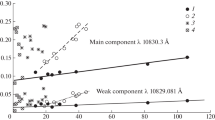Abstract
The magnetic properties of leading and trailing sunspots were compared based on SDO/HMI and SDO/AIA data with a high spatial resolution for the growth phase and maximum of cycle 24. The properties of the solar atmosphere above sunspots are also discussed independently for both of these sunspot types. It was shown that the contrast in the He II 304 (C 304) line above the umbra of leading and single sunspots is on average smaller than such a contrast above the umbra of trailing sunspots and on average weakly depends on the umbra area for both C 304 sunspot types. It was established that the minimal angle between the field direction and the normal to the solar surface at the field measurement site is smaller in leading sunspots than in trailing ones (αmin − ls < αmin − fs ) in 84% of the considered magnetically connected “leading-trailing” sunspot pairs, and a positive correlation exists between angles αmin − ls and αmin − fs . It was found that the C 304 contrast increases with decreasing αmin − ls, fs for leading and trailing sunspots, and the C 304 − ls /C 304 − fs ratio on average decreases with increasing αmin − ls /αmin − fs ratio. The dependences of the maximal and average magnetic induction values in an umbra on the umbra area were constructed for the first time and compared independently for leading and trailing sunspots. It was concluded that the maximal and average magnetic field values do not vanish when the umbra area decreases to very small values. In all cases the magnetic field in leading and single sunspots is larger than in trailing ones.
Similar content being viewed by others
References
Akhtemov, Z.S., Andreeva, O.A., Rudenko, G.V., Stepanian, N.N., and Fainstein, V.G., Temporal variations in the large-scale magnetic field of the solar atmosphere at heights from the photosphere to the source surface, Bull. Crimean Astrophys. Observatory, 2014, vol. 110, pp. 108–118.
Antalova, A., The relation of the sunspot magnetic field and penumbra-umbra radius ratio, Astron. Inst. Czechosl. Bull., 1991, vol. 42, pp. 316–320.
Baranov, A.V., Magnetic fields of small sunspots, Astron. Tsirk., 1974, vol. 847, p. 5.
Beckers, J.M. and Schroter, E.H., The intensity, velocity and magnetic structure of a sunspot region. I: Observational technique; properties of magnetic knots, Sol. Phys., 1968, vol. 4, no. 2, pp. 142–164.
Bray, R. and Loughed, R., Sunspots, London: Chapman and Hall, 1964.
Bumba, V., Magnetic fields in small and young sunspots, Sol. Phys., 1967, vol. 1, nos. 3–4, pp. 371–376.
Harvey, J., Solar magnetic fields-small scale, Publ. Astron. Soc. Pac., 1971, vol. 83, no. 495, pp. 539–549.
Harvey, J. and Livingston, W., Magnetograph measurements with temperature-sensitive lines, Sol. Phys., 1969, vol. 10, no. 2, pp. 283–293.
Houtgast, J. and Sluiters, A.Van., Statistical investigations concerning the magnetic fields of sunspots. I, Bull. Aston. Inst. Netherlands, 1948, vol. 10, pp. 325–333.
Jin, C.L., Qu, Z.Q., Xu, C.L., Jhang, X.Y., and Sun, M.G., The relationships of sunspot magnetic field strength with sunspot area, umbral area and penumbra-umbra radius ratio, Astrophys. Space Sci., 2006, vol. 306, nos. 1–2, pp. 23–27.
Kuklin, G.V., East-west asymmetry of the Wilson effect, Issled. Geomagn. Aeron. Fiz. Solntsa, 1985, vol. 73, p. 52.
Lemen, J.R., Title, A.M., Akin, D.J., et al., The atmospheric imaging assembly (AIA) on the solar dynamics observatory (SDO), Sol. Phys., 2012, vol. 275, nos. 1–2, pp. 17–40.
Livingston, W. and Harvey, J., Observational evidence for quantization in photospheric magnetic flux, Sol. Phys., 1969, vol. 10, pp. 294–296.
Livshits, M.A., Constancy of tau /10830/ in plages and helium emission in a shortwave-radiation field, Astron. Rep., 1975, vol. 52, p. 970–974.
Maltby, P., Continuum observations and empirical models of the thermal structure of sunspots, Proc. NATO Advanced Research Workshop on the Theory of Sunspots, Cambridge, 1992, pp. 103–120.
Nikol’skaya, K.I., He I excitation in chromospheric spicules, Astron. Rep., 1966, vol. 43, p. 936.
Obridko, V.N., Solnechnye pyatna (Sunspots), Moscow: Nauka, 1985.
Pipin, V.V. and Kosovichev, A.G., The subsurface-shear-shaped solar αΩ dynamo, Astrophys. J., 2011, vol. 727, no. 2, pp. 1–4.
Pozhalova, Zh.A., The study of selected helium lines in the solar spectrum, Astron. Rep., 1988, vol. 65, pp. 1037–1046.
Ringnes, T.B. and Jensen, E., On the relation between magnetic fields of sunspots in the interval 1917–56, Astrophys. Norvegica, 1960, vol. 7, no. 4, pp. 99–121.
Rudenko, G.V., Extrapolation of the solar magnetic field within the potential-field approximation from full-disk magnetograms, Sol. Phys., 2001, vol. 198, no. 1, pp. 5–30.
Sheeley, N.R., Measurements of solar magnetic fields, Astrophys. J., 1966, vol. 144, pp. 723–732.
Sheeley, N.R., Observations of small-scale solar magnetic fields, Sol. Phys., 1967, vol. 1, pp. 171–179.
Sobotka, M., Semi-empirical models of sunspots in various phases of evolution, Contrib. Astron. Obs. Skalnate Pleso, 1986, vol. 15, pp. 315–318.
Solov’ev, A. and Kirichek, E., Basic properties of sunspots: Equilibrium, stability and long-term eigen oscillations, Astrophys. Space Sci., 2014, vol. 352, no. 1, pp. 23–42.
Stenflo, J.O., Magnetic-field structure of the photospheric network, Sol. Phys., 1973, vol. 32, no. 1, pp. 41–63.
Steshenko, N.V., Magnetic field of small sunspots and pores, Bull. Crimean Astrophys. Observatory, 1967, vol. 37, pp. 21–26.
Vitinsky, Yu.I., Kopetsky, M., and Kuklin, G.V., Statistika pyatnoobrazovatel’noi deyatel’nosti Solntsa (Sunspot Formation Activity Statistics), Moscow: Nauka, 1986.
Zagainova, Yu.S., He II λ304 emission above sunspot umbrae, Astron. Rep., 2011, vol. 55, no. 2, pp. 159–162.
Zagainova, Yu.S., Fainshtein, V.G., Rudenko, G.V., and Obridko, V.N., Comparative analysis of magnetic field properties in leading and trailing sunspots, Astron. Rep., 2014, no. 9, pp, 19–27.
Author information
Authors and Affiliations
Corresponding author
Additional information
Original Russian Text © Yu.S. Zagainova, V.G. Fainshtein, V.N. Obridko, 2015, published in Geomagnetizm i Aeronomiya, 2015, Vol. 55, No. 1, pp. 15–25.
Rights and permissions
About this article
Cite this article
Zagainova, Y.S., Fainshtein, V.G. & Obridko, V.N. Comparison of the properties of leading and trailing sunspots. Geomagn. Aeron. 55, 13–23 (2015). https://doi.org/10.1134/S001679321406022X
Received:
Published:
Issue Date:
DOI: https://doi.org/10.1134/S001679321406022X




